 Wayne Szalinski has good news and bad news. The good news is that he has invented a ray gun that can shrink matter down to a fraction of its normal size. This is easily the most important scientific discovery since splitting the atom, and it has the potential to transform the entire planet forever. The bad news is that honey, he shrunk the kids.
Wayne Szalinski has good news and bad news. The good news is that he has invented a ray gun that can shrink matter down to a fraction of its normal size. This is easily the most important scientific discovery since splitting the atom, and it has the potential to transform the entire planet forever. The bad news is that honey, he shrunk the kids.
Actually, he not only shrunk his own kids, he shrunk his neighbors’ as well. Then he inadvertently swept them up, put them in a garbage bag, and took them out to the curb. After sliding down a giant blade of grass, Wayne’s son muses, “We’re now a quarter of an inch tall and 64 feet from the house. That’s the equivalent of 3.2 miles.” Confusingly, Wayne later says, “At their size, that backyard is like 10 miles,” which is such a different number I wonder if left over from another draft of the script. In any case, it’s a long way.
But Wayne’s a brilliant engineer. No doubt he will consider this problem logically and find a rational solution. Right? Maybe?
Wayne walks all over the lawn using stilts, looking for the kids through helmet-mounted binoculars.
STUPID BECAUSE: Oh, let me count the ways. First of all, while the stilts have less surface area than shoes, they are still perfectly capable of smushing the kids. Secondly, all the binoculars are good for is seeing the blades of grass more clearly. To find the kids, Wayne would have to carefully push the grass aside to inspect the actual ground. But the biggest downside of the stilts is that they’re highly unstable. Sure enough, Wayne somehow manages to turn on the sprinklers, and his daughter almost drowns. (Incidentally, this is the only PG-rated film I’ve ever seen featuring mouth-to-mouth resuscitation.)
He strings a cable from a second story window to a telephone pole. Then he suspends himself inches above the grass, counterbalanced by a TV. (If anyone has any theories about how you’d get into this device by yourself, go ahead and offer them.) This is more like it. Now he’s close enough to the ground to conduct a thorough investigation, without stomping all over the search area.
STUPID BECAUSE: Look, if you’re going to rest your arms right on the lawn, you might as well just walk on it. And conducting a visual search of every inch just isn’t practical. But his main mistake is letting the dog walk around freely, tromping all over the grass. Yes, the dog turns out to be integral in rescuing the kids, but Wayne should probably keep that thing locked inside. He can clean the carpet later.
Same as plan B, except now he’s got his wife as the counterweight.
STUPID BECAUSE: Once again, he’s spinning around by putting his hands all over the ground. That seems like small potatoes when his wife suddenly pulls the ripcord, dropping him onto the lawn and flattening up to ten square feet of real estate. But most importantly, this plan just doesn’t work. At one point, there’s a shot of Wayne passing directly over the kids, magnifying glass inches away from them, and he doesn’t notice.
WAYNE’S PLAN D
Diane Szalinski: They’re going to head right for the house.
Wayne Szalinski: You’re probably right. We just got to keep our eyes open.
STUPID BECAUSE: “We just got to keep our eyes open,” really? That’s the plan to find your children? That’s the plan I use when I lose my KEYS. Actually, no. When I lose my keys, I actively search for them. “We just got to keep our eyes open” is what you do when you’re missing something that’s not worth interrupting your routine over. When I can’t find my summer camp yearbook from 1994, I keep my eyes open. Here we have the greatest inventor since Thomas Edison, and that’s the best he can do.
We can do better.

One of the movie's many ironies is that while the kids are swept up, the couch is not. So by fleeing the broom, they sealed their fate.
Right off the bat, Wayne is basing his strategy on a completely unfounded assumption: that the kids would attempt to cross the lawn by themselves. Couldn’t they have decided to stay near the bag, in the hopes that he would come looking for them? It’s not as crazy as it sounds. In addition to the kids, the shrinking ray diminished Wayne’s couch and chair. The kids saw this before he swept them up. Isn’t it logical to assume that before long, Wayne’s going to notice the missing furniture, put two and two together, and check the trash bag. (In fact, this is exactly what happens.)
There are other reasons to focus the search on the bag, and not the grass. When Wayne realized he had accidentally thrown out the kids, he should have considered the possibility (perhaps the likelihood) that one or more of them was hurt during this process. In that case, they would have no choice but to stay put. He really shouldn’t be examining the entire lawn until he’s dissected every centimeter of that trash bag and the immediate surroundings.
(Wayne’s not the only person who isn’t thinking straight, FYI. Any wilderness survival manual will tell you that if you’re lost, your best strategy is to stay put and wait for rescue. If you wander aimlessly into unfamiliar territory, you make yourself far more difficult for rescuers to find, and you risk injury and exhaustion. In this case, the kids aren’t really lost – they can see the house, so they will always be heading in the right direction. But will reaching the house improve their situation? How are they planning to get up the porch steps, which might as well be El Capitan?)
Okay, let’s summarize what Wayne knows:
- The kids have no way of communicating with Wayne.
- Wayne is not likely to spot the kids by manually searching. He should realize this almost instantly. It is like looking for one ant on the whole lawn (quite literally, since the kids ride an ant for a while).
- But Wayne quite clearly believes the kids can hear HIM. “Kids,” he says, repeatedly. “Where are you?”
Under these conditions, Wayne’s best option is to give the kids instructions vocally. The simplest version of this would be: “Kids, I’m leaving a blank sheet of paper duct-taped to the stoop! I’ll check it every thirty minutes. Just make your way to that!” Provide the kids with some guidance, so at the very least you can establish a target. But why stop with just one target? The kids mention at one point that there’s a flagstone in the middle of the yard. All Wayne would have to do is take one of his son’s Hot Wheels, put it on the stone, and start yelling for the kids to make their way to that. Instantly, he’s cut the distance the kids have to travel in half.

Disney family adventures for some, miniature American flags for all!
Let’s take it further. What if Wayne bought himself a package of 30 miniature American flags on tiny sticks. Then he uses his pully system to stick these in the grass at regular intervals. He could just tell the kids to go to the nearest flag and stay at the base until he finds them. That way, he limits the portion of the lawn he needs to examine to 30 square inches, and the maximum distance the kids need to travel to less than a mile relative to their size. Even if they are injured, this seems doable. Bonus: the lawn would be ultra patriotic.
Within the world of the movie, that’s your dominant strategy: very carefully placing markers on the lawn and giving the kids verbal instructions, thus saving them a very difficult and dangerous journey with no clear goal. But in the spirit of Overthinking It, I need to point out that if you could shrink people down to that size, there’s no way they would be able to hear you. I’m not a biologist, but I do play one on the internet, and I can think of at least three reasons why your ears would stop functioning normally at that size:
-
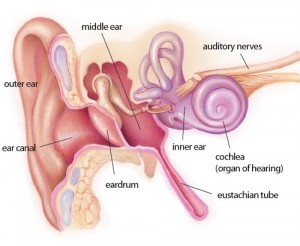
If there are any Otolaryngologists reading, I look forward to reading your comments.
Your eardrums are strong enough to withstand a certain intensity level. However, by shrinking that membrane hundreds of times, you’re making it as delicate as tissue paper. The sound of Wayne yelling would create vibrations in the air that could potentially destroy their tiny ears forever. The movie actually makes a nod to this theory: when the dog barks, the shrunken kids all wince in pain.
- Or maybe the opposite is true: ears that small are no more capable of hearing Wayne talk from across the lawn than I’m capable of listing to a conversation five miles away. Think about it: animals with good hearing, like bloodhounds, tend to have large ears. If we want to hear something better, we cup our hand to our ear. Clearly, the larger the ear, the better it hears. Making the ear microscopic might make it incapable of detecting sounds from more than a few inches away, like the world’s weakest microphone.
- Finally, I’m pretty sure a shrunken ear would detect a radically different frequency range than a regular ear. Our perception of pitch has to do with the size of our eardrum, and the size of the fibers lining the basilar membrane. No, I don’t know exactly what this means, but I’m pretty sure that human speech would sound like a low rumble to a mini-ear. Of course, your shrunken voicebox would produce a high-pitched squeak that would be beyond the range of NORMAL human hearing, but your tiny ears would perceive it as unchanged, since the hearing apparatus was scaled down proportionally to the vocal apparatus.
In the movie, the kids are perfectly able to understand what their parents are saying. But let’s pretend the movie was slightly more realistic, and their ears were useless. In that case, Wayne should be relying on another sense: sight. If you assume that all regular biochemistry applies to the kids’ shrunken bodies, I believe their eyes should function normally. And so Wayne should be suspending signs above the lawn – the equivalent of skywriting. “FIND NEAREST AMERICAN FLAG,” they should say. “WAIT FOR HELP.” Good advice whether you’re lost in a foreign country or your own backyard.
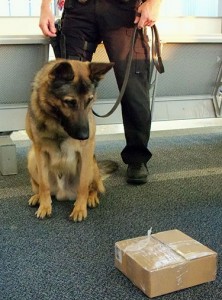
Imagine this suspicious package is a shrunken kid.
But the best strategy might be similar to the way the kids are eventually found in the film. The family dog has no trouble detecting them despite their miniature size. When all seems lost, he allows them to cling to his fur and gives them a ride to the kitchen. It’s a classic deus ex Jack Russell. And this got me thinking about the legendary skills of scent hounds. Dogs can detect incredibly faint traces in the air. Perhaps, say, the smell of a group of children a quarter inch tall. Granted, having a dog search the whole yard would involve a lot of trampling. Maybe Wayne could rig up some sort of doggie harness to suspend the dogs over the lawn, sliding them slowly across the grass and waiting for them to bark.
So what do you guys think? Any other clever strategies for finding the kids? More importantly, how would a human ear function if it were the size of a pinhead?
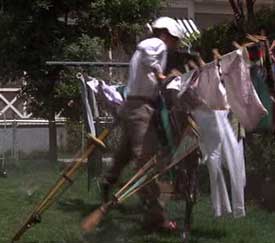
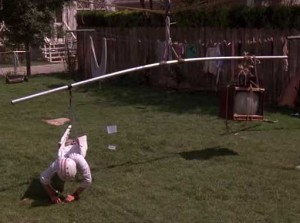
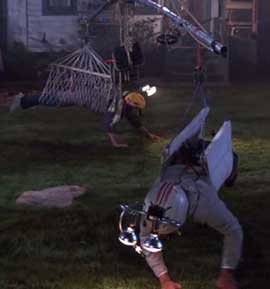
It’s a good point about the function of the ears, but it’s one of those methods of analysis that breaks the entire movie.
That is, if you consider the physics that makes their ears useless at that size, you also have to consider that the vastly smaller radius of their bronchii and blood vessels makes viscous flow of air and blood impossible. They’d die in minutes. You can maybe excuse the blood portion by saying that the blood got shrunk with the kids, but they have to breathe unshrunken air, which has no chance of squeezing through their bronchii.)
Even overlooking that, all of the surface-area-volume ratios in your body would be off. Your heart would be the wrong size for your vascular system. Your now-comparatively-huge skin would dissipate much more heat than usual. There’s a reason that tiny mammals have crazy fast metabolisms– they have to generate much more heat than larger ones. And the kids are much smaller than, say, a vole. Assuming they could breathe long enough, they’d find themselves unable to maintain their core temperatures and die of hypothermia.
So, if you’re suspending belief enough to accept the premise of the movie, I think you have to spot them functional hearing as part of the package.
(Also, The Sandlot is PG and not only features mouth-to-mouth, it makes a joke about the similarity to kissing. I guess playing it for comedy instead of drama is different, though.)
Damn, you had the same concern, but far better worded!
How would the surface-area-volume ratios be off? Wouldn’t the ratios be the same because the bodies were shrunken proportionally?
No, they wouldn’t, and it’s because they shrunk proportionately.
Imagine a cube that’s 2 m on its side.
Its volume is (2m)^3= 8 cubic meters.
Its surface area is 6*(2m) ^2= 24 square meters.
That’s a SA:V ratio of 3 square meters per cubic meter.
Now imagine we (proportionately!) shrink it by half. It’s still a cube. It’s now one meter on its side.
Its volume is 1 cubic meter.
Its surface area is 6*(1m)^2 = 6 square meters.
That’s a SA:V ratio of 6 square meters per cubic meter.
Basically, surface area is a function of the square of the distances involved, and volume is a function of the cube of the distances involved. So, very small things have very high surface areas compared to their volume.
To defend my point from the biophysicist downthread: I wasn’t trying to claim that air molecules wouldn’t fit through the bronchii. You’re right, it still totally would.
But the grasshopper example proves my point: grasshoppers don’t have lungs. They’re relying on diffusion to get gases to travel those distances.
I was trying, perhaps unsuccessfully, to communicate that the resistance to fluid flow through tubes is proportional to the surface area of those pipes, and the amount of gas is proportional to the volume. So, way more resistance on that air flow.(Also, the gas exchange is trying to be driven by a change in the volume to the chest cavity, and that volume differential has also shrunk on the cube of the distance.)
So I’m guessing that trying to breathe with proportionally shrunken lungs would feel a lot like trying to inhale maple syrup, even if the oxygen molecules had functional hemoglobin waiting for them. (Which I agree they wouldn’t.)
Great analysis! Obviously the writers were neither engineers nor biologists…
The ear issue touches on the biggest problem I had with that movie as a kid. Do the cells themselves shrink? If every cell in your body shrinks according the same scale, could it even be functional? Isn’t there a limit to how small a functioning cell could be? Or is it even deeper? Do the atoms or sub-atomic particles get smaller?
Science ruins everything.
I think he explicitly says something like ‘the shrinking occurs because the spacing between atoms decreases’, but it’s been a long time since I’ve seen the movie.
One of the great internet articles of all time.
The most curious thing about the movie, is if the shrinking process really works by reducing the electron-cloud size (all the atomic empty space), it wouldn’t actually change the mass of the person. So, suddenly you would have incredibly dense people, focused into a tiny area. I wonder if it wouldn’t result in them collapsing in on themselves into a micro black hole and exploding.
Sad ending, cool way to die.
I think you’d have to be much denser to get into even micro black hole territory. The Schwarzschild radius is R = 2GM/c^2, so for a mass of 80 kg (about 175 lbs), the radius would be 1.2*10^(-25) meters!
It’s been a while since I’ve seen the movie, but wasn’t one of the early problems with the shrink ray that it was exploding things? So maybe density was a problem, and it was fixed when the apple hit the shrink ray.
If the kids (and the furniture) retain their original mass, then how did he carry the garbage bag to the curb in the first place? I haven’t seen the movie.
The kid is much closer than Wayne is on the distance estimate. 64 ft * 12 in/ft * 4 in/person = 3072 person heights. Putting an average height at around 6 feet, that’s something like 3.5 miles.
Not to mention the fact that the supposed reason for the invention of the shrink ray is to increase worldwide shipping capacity. If you fill a plane or a ship with shrunken cargo, your shipment is going to weigh something like 200 times what a non-shrunken load would weigh!
So the shrunken kids weigh the same as they do at regular size? If you shrink the cargo in size and also mass (as indicated by the kids being able to climb on the grass etc), it would even out wouldn’t it because the overall density would be the same?
@Devon: Science makes everything better. Look at the profound impact it’s had on the snack food industry.
Okay, as a certified, Ph.D-wielding Biophysicist, I feel like I should chime in on this, since the biggest problem with _H,ISTK_ is biophysical in nature. As several of you pointed out, the physical explanation as to how the shrink-ray works is that it removes the “excess” space between nuclei and electrons in its targets’ atoms. This, of course, is a basic and profound violation of quantum mechanics (electrons don’t orbit nuclei in any haphazard way; their orbits are limited to the discrete set of wavefunctions allowable in the given system).
SO, in order for us to buy that this particular brand of shrink-ray could ever work, we’d have to posit that the ray generates some sort of field within which the laws of quantum electrodynamics work differently. Or at least, in which the attainable orbitals electrons occupy are now stably smaller. As a side-note, this might entail diminishing the masses of the targets’ atomic nuclei, though this is rife with *all* sorts of other problems (reduce mass by altering the number of protons? Chemistry becomes totally different! Reduce it by altering the number of neutrons? Stuff becomes radioactive! Reduce it by altering the strong nuclear force? Mini black holes for everyone!). Let’s assume it works by an established Sci-Fi principle called “Just Trust Me; It’s Complicated”
Evey obeying JTM;IC, though, we quickly run into a second major road-block, considering the *bio*phyiscs of the system. “The System,” here, of course, refers to a group of human children (as it so often does in scientific articles). And, coincident with the core argument of this OTI article, this problem deals less with the shrunken kids themselves, and more with the way their newly-beshrunken bodies interact with their non-beshrunken environment. Hence, the issue is hard to work around by just shruggingly attributing it to the mysterious physics of the shrink-ray.
To illustrate, let’s consider the mechanism by which oxygen gets carried around in your blood. Here Transcriptase (LOVE the name, btw) dinged the nail, but didn’t quite hit it. After all, their bronchii aren’t any smaller than, say, the spiracles on a grasshopper’s abdomen, and grasshoppers breathe just fine. So, air’d have no problem getting in and out of the kids, it would just do so unaltered.
As many of you might know, most animals produce proteins called Hemoglobins*, whose business end is a tightly-held iron atom with a (+2) positive charge. The protein happens to hold that iron atom (by holding onto a smaller, iron-binding molecule called – appropriately enough – Heme**) in such a way that a pair of the iron’s electrons – stably bopping along in a pre-defined orbital – protrude outward from the surface of the protein. This iron is positioned in a _perfectly_ defined structure so as to be able to bind an oxygen molecule (less so, a carbon dioxide molecule, though moreso a carbon monoxide molecule – which is where so many cheaply-written plot devices come from.). The protein then works as follows: hemeoglobin carrying CO2 wanders its way into your lungs, exchanges that CO2 for a bound O2, and then swims back out to the rest of your body, where it does the reverse exchange. Wrather, rinse, repeat.
Now, ask yourself the question: what happens if we shrink all of the atoms in your body – including those in your Hemoglobin, their bound hemes, and the bound iron atoms within – ~100-fold? Moreover, what happens if we apply this shrinkage by mucking up the electronic orbitals in all of your atoms? Well, I guess everything’d be okay, really.
Until you tried to breathe.
At THIS point, the iron in your blood would prove ~100-fold too small to bind the oxygen in the atmosphere***. You’d quickly suffocate, and not because the protein itself isn’t working: after all, its internal parts are interfacing with each other just fine, and it’s being pumped through your body in the same manner as before. No, the problem lies in the fact that, while you were getting shrunk, the world’s oxygen supply wasn’t.
Now, one might posit that the shrink ray imbues its targets with some sort of local alteration-field: in the immediate vicinity, a be-shrunken object would “warp” other matter down to its size. This’d solve the breathing problem, but raises a host of others. To wit, the kids would never be able to stand on a solid floor; anything they touched would shrink, and the discontinuity created at the edge of their local field would begin to rip holes in whatever surface they’re on. Also, we have no evidence that anything like this is happening in the movie.
One might also posit that, since _H,ISTK_ a family-friendly Rick Moranis vehicle, one cannot demand such a deep level of scientific rigor. But THAT, friends, is hardly OverThinking.
Better living through chemistry,
Sheq
*-Haemoglobins, if they’re British.
**-Haeme, if it’s British.
***-Fog, in Britain.
I think we’re missing one freakish aspect of the movie. If those kids are accurate in stating they are 1/4″ tall, then these people have some giant ants walking around their yard.
The “10 miles” thing may not be an error. Perhaps Wayne meant it was 10 miles in area? That is, 3.2 miles squared comes out to about 10 miles.
Wayne also knows that he got the kids in the trash after sweeping. So maybe if he was really careful about it, he could try sweeping or raking the lawn slowly and hope he catches his kids.
Can I ask what backyard has scorpions roaming about in it?
Oh, this was fun. Thank you.
The Sandlot also has mouth-to-mouth. PG rating
Infra red camera to pick up body heat.
– problem, small objects lose heat faster
– your kids are gonna die from freezing to death… sorry :(
Ha! I really liked your new ideas although, in Wayne’s defense, he DID check the area around the garbage back and wasn’t able to find them. That’s when he knew they were crossing the lawn.
Great article.
OMG this post made me laugh so much I was crying at my desk, and had to leave the office area so I wouldn’t disturb my fellow coworkers (after choking on some water trying to calm down). “Plan D Stupid Because” = double points
I always thought some of the proportions didn’t seem right, actually. Example: I found the idea that the kid could ride an ant but then fit inside a Cheerio rather contradictory. So I’m with EZ, ish: either there were some serious production problems, or that family has a MAJOR bug problem. That’s about as far as I’m capable of, though.
Will there be a Part II article about Honey, I Blew Up the Kid?
In the DS9 episode “One Little Ship”, a similar shrinking process occurred. In the episode, one of the shuttles (and it’s occupants) was shrunk due to a spatial anomaly. There’s a scene that corroborates exactly what shechner mentioned; the oxygen molecules outside the shuttle are too big to be absorbed by the hemoglobin of the shrunken officers. In the episode, our heroes need to reprogram a computer from the inside (due to the B story). They compensate for this by beaming in some of their own air from the shuttle into the conveniently vacuum sealed computer. Unfortunately, due to the vacuum, the air gets thin after a while which made the job more difficult. Anywho, I just thought it was worth mentioning that, given the same plot device, the good people at Star Trek used a little more science power than Wayne Szalinski. Then again, I never saw any Radio Controlled Lawn Mowers in Trek! =)
Wait! Does both this movie and DS9 have a character named Quark!? o_O
When I first watched the movie, I wondered why they just didn’t collect a bunch of grass and set it on fire.
A single blade of grass burning would easily be visible to the naked eye, especially if you did it at night.